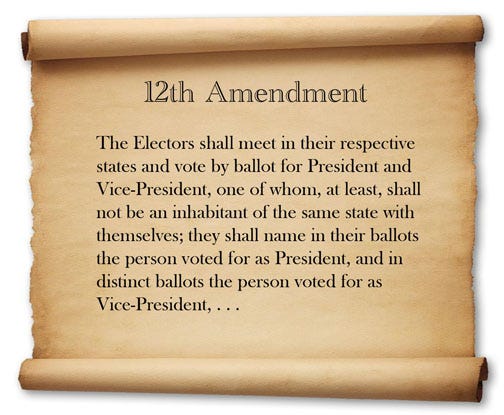The 12th Amendment of the Constitution
Understanding Its Historical Significance and Current Implications
Issue #372 Government August 24, 2023
An ongoing series for our Thursday topic of "Government" includes an article about each of the twenty-seven ratified amendments to the Constitution of the United States.
The first ten amendments, passed almost immediately after the 1787 ratification of the Constitution, are collectively called the Bill of Rights. The 13th, 14th, and 15th Amendments are collectively known as the Reconstruction Amendments. The 19th Amendment, passed in 1920, gave (white) women the right to vote.
There are still six unratified amendments, including the Equal Rights Amendment.
So what about some of the "lesser-known" amendments? Even they are important to the history of the United States of America.
The 1800 election was a rematch between John Adams and Thomas Jefferson. At the time, the top vote-getter would be named president and the person who received the 2nd highest number of votes would be named vice-president. After the election resulted in a tie for president so no votes for vice president, the election went to the House of Representatives, which was controlled by members of the Federalist Society.
A total of 36 ballots were cast, and eventually, Thomas Jefferson was elected president and Aaron Burr vice president.
The 12th Amendment to the United States Constitution, ratified in 1804, primarily changed the procedure for electing the president and vice president and was passed in response to the electoral complications during the 1800 presidential election. The amendment resolved issues in the original Constitution's election process, and separated votes for president and vice president, preventing ties in the future.
Today, the 12th Amendment continues to define the structure of the Electoral College and the presidential election process. Every four years, electors cast separate votes for president and vice president. If no candidate receives an absolute majority, the House of Representatives chooses the president, and the Senate chooses the vice president.
The candidates for president and vice president must come from different states, and the elections are still run by the states. We don’t have a “national election.”
Although these days, the presidential and vice presidential candidates almost always run as a “team,” they are still listed separately on the ballot. The 12th Amendment also allows for running mates of different political parties and prevents a president from appointing their vice president to an executive or judicial branch position.
A quick reminder that the vice president, acting as president of the Senate during the constitutionally-mandated counting of the electoral college votes that were certified by each state on the prior December 14, does not have the ability to change those electoral college votes.
What Trump was trying to get Pence to do was to send the 2020 election back to the states where the majority of the legislatures were headed by Republicans, hoping that those legislatures would vote for him even though he lost both the popular vote and the electoral college vote.
Let's be clear, Trump and his allies and his Department of Justice are the ones who tried to steal the election from the 81 million of us who voted for Joe Biden. NO ONE tried to "steal the election" from Trump except in his mind.
Let us know your thoughts about what new information you learned in the comments or in the Substack Notes feature.
You can always leave any questions in the comments or email us.
You can also receive up to six months of a paid subscription for referring people to us with the Share Button or the Refer Button.
Our goal is to make “We Are Speaking” into a multi-dimensional written and audio/visual publication and resource for you.
It will take financial resources to grow our publication.
Please consider becoming a paid subscriber for $5/month or less to access all of the articles, the entire archive, and other benefits.




